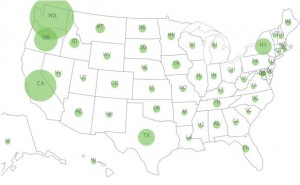According to the U.S. Energy Information Administration – which provides data and analysis on a broad range of energy topics – Washington was the top consumer of renewable energy in the United States during 2011. Washington led the way with over 950 trillion BTUs of renewable energy, besting California by almost 300 trillion. Oregon, Texas and New York rounded out the top five states.
 Our top spot is largely a result of our abundance of hydroelectric power, which is the source of 91 percent of our renewable energy and nearly two thirds of our total electric capacity. Washington is the leading producer of hydroelectricity power, and the Grand Coulee Dam on the Columbia River is the largest hydro station in the United States.
Our top spot is largely a result of our abundance of hydroelectric power, which is the source of 91 percent of our renewable energy and nearly two thirds of our total electric capacity. Washington is the leading producer of hydroelectricity power, and the Grand Coulee Dam on the Columbia River is the largest hydro station in the United States.
Beyond being completely clean and renewable, hydro power is also one of the cheapest sources of electricity. This is one of the main reasons why Washington has some of the lowest electricity rates in the country.
But we are not content to rest on our laurels. Washington was the second state in the nation to create a renewable portfolio standard in 2006 when the people passed Initiative 937. The initiative requires large utilities to obtain 15 percent of their electricity from non-hydro renewable sources by 2020, with incremental benchmarks along the way. That has played a major role in the push towards the cleaner, more sustainable energy sources that earned Washington this distinction.
